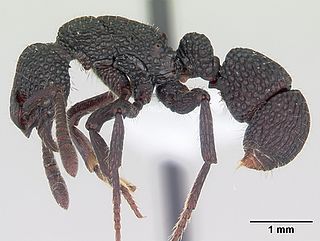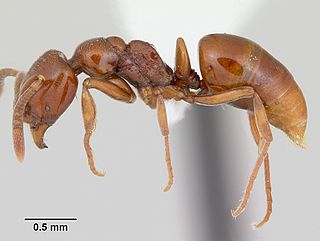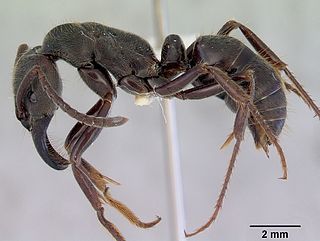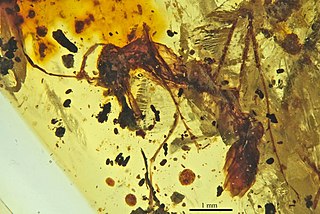
Adetomyrma is a genus of ants endemic to Madagascar. Workers of this genus are blind. The type species Adetomyrma venatrix was described in 1994, with the genus being an atypical member of its tribe, the Amblyoponini. This tribe includes the Dracula ants, members of which can feed on the hemolymph of larvae and pupae.

Feroponera is a monotypic Afrotropical genus of ants in the subfamily Ponerinae containing the single species Feroponera ferox. The genus is known only from a few specimen collected from an unoccupied termitary in Cameroon.

Centromyrmex is a pantropical, though mainly Afrotropical, genus of ants in the subfamily Ponerinae. This ponerine ant was recorded for the first time in French Guiana and the most northerly point of recording was in Costa Rica. The specimens reported here were collected in a region of Amazon Forest with flight interception traps.

Thaumatomyrmex is a Neotropical genus of ants in the subfamily Ponerinae, found from Mexico to Brazil. They are notable for their pitchfork-shaped mandibles, which they use to capture millipedes of the order Polyxenida. The genus is a specialist predator of polyxenids, and one of only two ant genera known to prey upon polyxenids.

Ypresiomyrma is an extinct genus of ants in the subfamily Myrmeciinae that was described in 2006. There are four species described; one species is from the Isle of Fur in Denmark, two are from the McAbee Fossil Beds in British Columbia, Canada, and the fourth from the Bol’shaya Svetlovodnaya fossil site in Russia. The queens of this genus are large, the mandibles are elongated and the eyes are well developed; a stinger is also present. The behaviour of these ants would have been similar to that of extant Myrmeciinae ants, such as solitary foraging for arthropod prey and never leaving pheromone trails. The alates were poor flyers due to their size, and birds and animals most likely preyed on these ants. Ypresiomyrma is not assigned to any tribe, and is instead generally regarded as incertae sedis within Myrmeciinae. However, some authors believe Ypresiomyrma should be assigned as incertae sedis within Formicidae.

Loboponera is an Afrotropical genus of ants in the subfamily Ponerinae with nine recognized species. The genus is found in central and western Africa, from Ivory Coast to Rwanda. Little is known about their biology.

Brownimecia is an extinct genus of ants, the only genus in the tribe Brownimeciini and subfamily Brownimeciinae of the Formicidae. Fossils of the single identified species, Brownimecia clavata, are known from the Middle Cretaceous of North America. The genus is one of several ants described from Middle Cretaceous ambers of New Jersey. Brownimecia was initially placed in the subfamily Ponerinae, until it was transferred to its own subfamily in 2003; it can be distinguished from other ants due to its unusual sickle-like mandibles and other morphological features that makes this ant unique among the Formicidae. The ant is also small, measuring 3.43 millimetres (0.135 in), and a stinger is present in almost all of the specimens collected. The morphology of the mandibles suggest a high level of feeding specialization.

Asphinctopone is a small genus of rarely encountered Afrotropical ants in the subfamily Ponerinae.

Dolioponera is a genus of small ants in the subfamily Ponerinae containing the single species Dolioponera fustigera. The genus is known only from a few specimens from west and central Africa. Little is known about their biology, and males remain unknown.

Odontoponera is a small Southeast Asia genus of ants in the subfamily Ponerinae.

Leptogenys is a genus of ants in the subfamily Ponerinae. Leptogenys is the most diverse ponerine ant genus in the world; it is widespread throughout tropical and subtropical regions and there are over 260 extant species described. Most species have ergatoid queens, and many have falcate, bowed mandibles and are specialists on isopod prey.

Promyopias is an Afrotropical genus of ant in the subfamily Ponerinae containing the single species Promyopias silvestrii. The rare genus has previously been regarded as a separate genus, as a subgenus and as a provisional synonymy, but was reinstated at genus-rank in 2008.

Buniapone is a monotypic genus of ants in the subfamily Ponerinae. Buniapone amblyops, the single described species, is found in Southern and Southeast Asia.

Iroponera is a monotypic genus of ants in the subfamily Ponerinae. Iroponera odax, the single described species, is known only from a few collections in Australia.

Brachyponera is genus of ants in the subfamily Ponerinae.

Paltothyreus is a monotypic genus of ants in the subfamily Ponerinae. Paltothyreus tarsatus, the single described species, is widely distributed in Sub-Saharan Africa. Workers are very large in size (17–20 mm); queens are similar to workers, but larger (23 mm) and winged.

Fisheropone is a genus of ants in the subfamily Ponerinae. Known from central Africa, it contains a single described species Fisheropone ambigua, and at least one undescribed species. Nothing is known about its biology.

Hagensia is a small genus of ants in the subfamily Ponerinae. Its two species are known only from coastal areas in South Africa. Workers are large (10.5–13.0 mm); queens are unknown, but gamergates occurs in both species.

Mayaponera is a genus of ants in the subfamily Ponerinae. It contains the single species Mayaponera constricta, found in Central and South America. Workers are slender and medium in size (6–7.5 mm).

Myanmyrma is an extinct genus of ants not placed into any Formicidae subfamily. Fossils of the single known species, Myanmyrma gracilis, are known from the Middle Cretaceous of Asia. The genus is one of several ants described from Middle Cretaceous ambers of Myanmar.




















